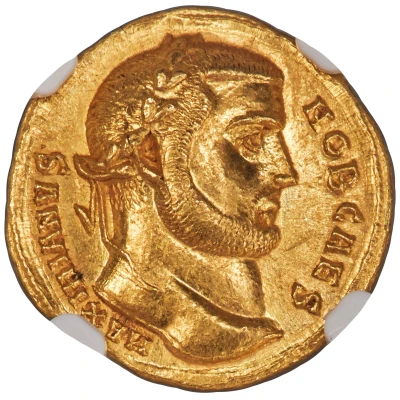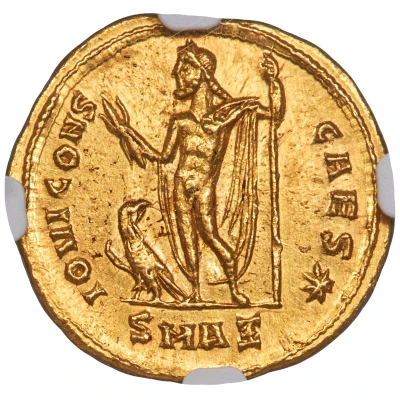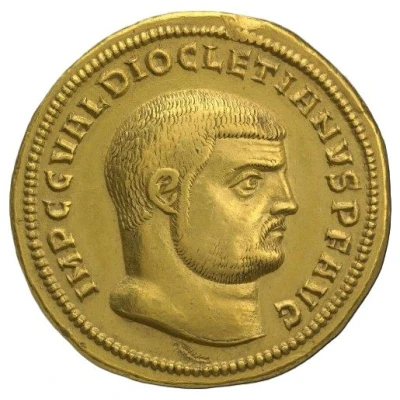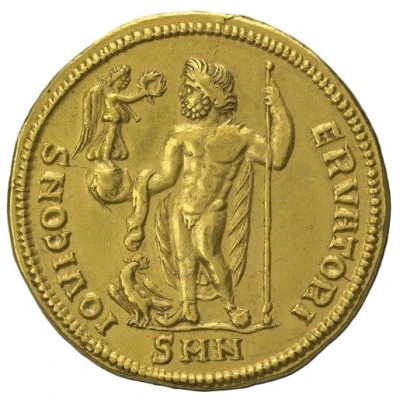


© Heritage Auctions
Aureus - Galerius IOVI CONS CAES; Antioch
| Gold | 5.35 g | 18 mm |
| Issuer | Rome › Roman Empire (27 BC - 395 AD) |
|---|---|
| Caesar | Galerius (Gaius Galerius Valerius Maximianus) (293-305) |
| Type | Standard circulation coin |
| Years | 293-295 |
| Value | Aureus (10) |
| Currency | Argenteus, Reform of Diocletian (AD 293/301 – 310/324) |
| Composition | Gold |
| Weight | 5.35 g |
| Diameter | 18 mm |
| Shape | Round (irregular) |
| Technique | Hammered |
| Orientation | Variable alignment ↺ |
| Demonetized | Yes |
| Updated | 2024-10-05 |
| Numista | N#380066 |
|---|---|
| Rarity index | 100% |
Reverse
Jupiter, chlamys spread behind, standing front, head left, holding thunderbolt in right hand and leaning on scepter with left hand; at feet to left, eagle; mintmark in exergue.
Scripts: Greek, Latin
Lettering:
IOVI CONS-CAES *
SMAΞ
Comment
Galerius began life as the son of a peasant herdsman. His mother, Romula, was a pagan priestess from the far side of the Danube who fueled his lifelong respect for the "old gods" of Rome and his hatred for Christianity. A large, imposing man, he found a career in the military and rose through the ranks to become Praetorian Prefect under Diocletian. On 1 March AD 293, Galerius was made Caesar of the East. Winning a decisive victory over Persia in AD 296, his influence over Diocletian grew steadily. In AD 302, he induced his senior to launch the Great Persecution - an all-out effort to crush Christianity root and branch.In AD 305, Diocletian abdicated and Galerius became Augustus of the East. He had already arranged that the new Caesars, Severus II and Maximinus Daza, would be exclusively loyal to him. However, the death of Constantius I the following year launched a chain reaction of upheaval that threw the Tetrarchic system into chaos, and Galerius spent the rest of his reign desperately trying to restore some semblance of order. In AD 310, he fell victim to a wasting disease that left him horribly disfigured and in constant pain. The Christians claimed it was God's vengeance, and Galerius seems to have at least partly believed it, for he ordered the persecution formally ended just five days before he died in May AD 311.
The weight standard of this aureus is indicated by the modified Ξ mark - the numerical equivalent of 60 in the Greek numbering system - thus 1/60th of a pound (approximately 5.46 grams). Variations in weight of this issue, in reality, are relatively commonplace.
Interesting fact
One interesting fact about the Aureus - Galerius (IOVI CONS CAES; Antioch) coin is that it features an image of the Roman god Jupiter on one side, and the emperor Galerius on the other. This coin was minted during a time when the Roman Empire was transitioning from a pagan to a Christian society, and the inclusion of Jupiter's image on the coin may have been a way for Galerius to appeal to both pagan and Christian populations. Additionally, the coin's gold content and intricate design make it a valuable and sought-after collector's item among numismatists today.



